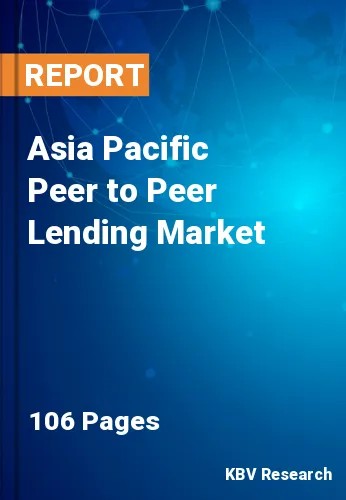The Asia Pacific Peer to Peer Lending Market would witness market growth of 29.1% CAGR during the forecast period (2023-2030).
Real estate P2P lending enables investors to pool funds and participate in real estate development projects. This application has democratized real estate investments, allowing individuals to enter the property sector without substantial capital. The rising education costs have driven many students and their families to explore P2P lending as a viable option for financing their studies. They offer more accommodating repayment options than traditional student loans. High-interest credit card debt can be a significant financial burden. P2P lending platforms provide an alternative for borrowers to refinance their credit card debt with lower-interest loans, potentially saving them money and helping to reduce their financial stress.
Additionally, P2P lending has the potential to reach individuals and businesses that may have been underserved or excluded by traditional financial institutions. This inclusivity is especially valuable in regions with limited access to traditional banking services. These platforms feature intuitive user interfaces that make it simple for lenders and borrowers to register, apply for loans, invest, and monitor their transactions. Accessibility through mobile applications further simplifies the process. P2P lending often boasts quicker approval and disbursement times than traditional banks, allowing borrowers to access funds when needed.
Moreover, India has a large, young, skilled workforce, a significant asset for startups and SMEs. These enterprises can tap into a talent pool well-versed in technology and entrepreneurship. India is witnessing rapid adoption of technology, including smartphones and internet access. This enables startups to reach a vast consumer base and SMEs to improve productivity and efficiency. As per the data given by the Ministry of Commerce and Industry of India, the Government, intending to build a robust ecosystem for nurturing innovation and startups and encouraging private investments in the country's startup ecosystem, launched the Startup India initiative on 16 January 2016. Since launching the Startup India initiative in 2016, the Department for Promotion of Industry and Internal Trade has recognized 92,683 entities as startups as of 28 February 2023. The demand for peer to peer lending in the Asia Pacific region will increase due to the rise in micro enterprises, SMEs, and startups in China and India.
The China market dominated the Asia Pacific Peer to Peer Lending Market by Country in 2022, and would continue to be a dominant market till 2030; thereby, achieving a market value of $63,710.1 Million by 2030. The Japan market is registering a CAGR of 28.2% during (2023 - 2030). Additionally, The India market would showcase a CAGR of 29.9% during (2023 - 2030).
Based on Business Model, the market is segmented into Traditional Lending, and Alternate Marketplace Lending. Based on Loan Type, the market is segmented into Small Business Loans, Consumer Credit Loans, Real estate Loans, and Student Loans. Based on End User, the market is segmented into Business, and Personal. Based on countries, the market is segmented into China, Japan, India, South Korea, Singapore, Malaysia, and Rest of Asia Pacific.
Free Valuable Insights: The Global Peer to Peer Lending Market is Predict to reach USD 1.1 Trillion by 2030, at a CAGR of 28%
The market research report covers the analysis of key stake holders of the market. Key companies profiled in the report include Harmoney Corp Limited, Funding Circle Limited (Funding Circle Holdings plc), LendingTree, LLC (LendingTree, Inc.), Upstart Network, Inc. (Upstart Holdings, Inc), LendingClub Bank (LendingClub Corporation), goPeer Corporation, Linked P2P Limited, Prosper Funding LLC (Prosper Marketplace, Inc.), Lending Loop (Loop Financial Inc.), and MoneyMe Limited.
By Business Model
By Loan Type
By End User
By Country
Our team of dedicated experts can provide you with attractive expansion opportunities for your business.

